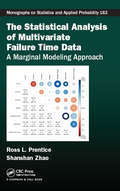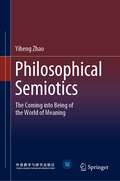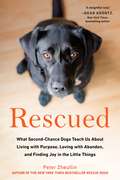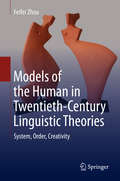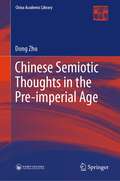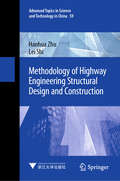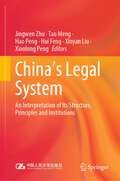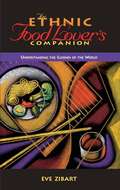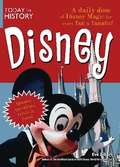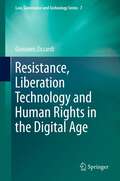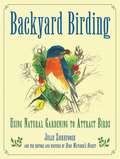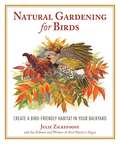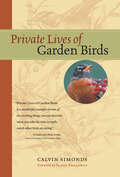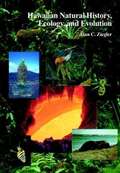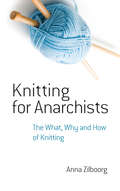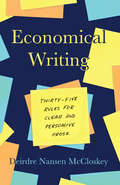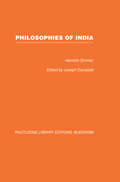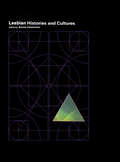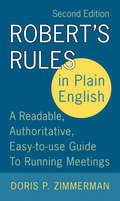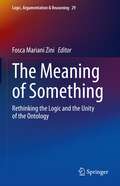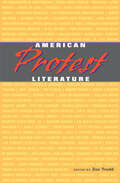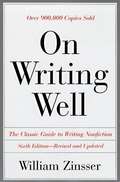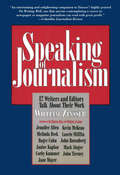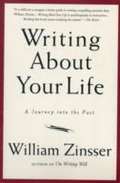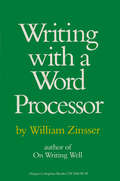- Table View
- List View
The Statistical Analysis of Multivariate Failure Time Data: A Marginal Modeling Approach (Chapman & Hall/CRC Monographs on Statistics and Applied Probability #1)
by Shanshan Zhao Ross PrenticeThe Statistical Analysis of Multivariate Failure Time Data: A Marginal Modeling Approach provides an innovative look at methods for the analysis of correlated failure times. The focus is on the use of marginal single and marginal double failure hazard rate estimators for the extraction of regression information. For example, in a context of randomized trial or cohort studies, the results go beyond that obtained by analyzing each failure time outcome in a univariate fashion. The book is addressed to researchers, practitioners, and graduate students, and can be used as a reference or as a graduate course text. Much of the literature on the analysis of censored correlated failure time data uses frailty or copula models to allow for residual dependencies among failure times, given covariates. In contrast, this book provides a detailed account of recently developed methods for the simultaneous estimation of marginal single and dual outcome hazard rate regression parameters, with emphasis on multiplicative (Cox) models. Illustrations are provided of the utility of these methods using Women’s Health Initiative randomized controlled trial data of menopausal hormones and of a low-fat dietary pattern intervention. As byproducts, these methods provide flexible semiparametric estimators of pairwise bivariate survivor functions at specified covariate histories, as well as semiparametric estimators of cross ratio and concordance functions given covariates. The presentation also describes how these innovative methods may extend to handle issues of dependent censorship, missing and mismeasured covariates, and joint modeling of failure times and covariates, setting the stage for additional theoretical and applied developments. This book extends and continues the style of the classic Statistical Analysis of Failure Time Data by Kalbfleisch and Prentice. Ross L. Prentice is Professor of Biostatistics at the Fred Hutchinson Cancer Research Center and University of Washington in Seattle, Washington. He is the recipient of COPSS Presidents and Fisher awards, the AACR Epidemiology/Prevention and Team Science awards, and is a member of the National Academy of Medicine. Shanshan Zhao is a Principal Investigator at the National Institute of Environmental Health Sciences in Research Triangle Park, North Carolina.
Philosophical Semiotics: The Coming into Being of the World of Meaning
by Yiheng ZhaoThis book attempts to solve the question whether semiotics is a methodology as is generally held and if the studies of meaning and the mind can shed light on a series of metaphysical issues, so that the edifice of semiotics could be erected on a philosophical ground. It proposes that a philosophical semiotics is, by necessity, a semiotic phenomenology about the construction of the “world of meaning” by signs, and any discussion about semiotics has to proceed around two core issues: meaning and the mind.This book particularly exemplifies the semiotic connections in various schools of traditional Chinese philosophies. In the “Pre-Imperial Age” (before BC 300), there emerged an abundance of semiotic thinking in China, from Yijing the first sign system that aims to explain everything in the world, to the Namists’s subtle argument about the form of meaning, from the Yin-Yang/five elements of the Han, to the “Things are non-existent while mind is non-non-existent” principle of the Vijñāptimātratāsiddhi School of Buddhism in the Tang, and from the Sudden Revelation of Chan Buddhism to the “Nothing outside the mind” endorsed by the Mindist Confucianism in the Ming. The mighty trend of philosophical heritage provides rich food to our understanding of the form of meaning.
Rescued: What Second-Chance Dogs Teach Us About Living with Purpose, Loving with Abandon, and Finding Joy in the Little Things
by Peter ZheutlinDiscover the astonishing lessons rescue dogs can teach us about life, love, and ourselves In the follow-up to his New York Times bestseller Rescue Road, acclaimed journalist Peter Zheutlin offers a heartwarming and often humorous new look into the world of rescue dogs. Sharing lessons from his own experiences adopting Labs with large personalities as well as stories and advice from dozens of families and rescue advocates, Zheutlin reveals the surprising and inspiring life lessons rescue dogs can teach us, such as: - How to “walk a mile in a dog’s paws” to get a brand-new perspective - Living with a dog is not one continuous Hallmark moment—but it’s never dull! - Why having a dog helps you see your faults and quirks in a new light, even if you can’t “shed” them completely - How to set the world right, one dog at a time For anyone who loves, lives with, or has ever wanted a dog, this charming book shows how the dogs whose lives we save can change ours for the better too.
Models of the Human in Twentieth-Century Linguistic Theories: System, Order, Creativity
by Feifei ZhouThis book provides a refreshingly new perspective for investigating linguistic texts, which foregrounds models of the human. It presents a close reading of major linguistic theories in the twentieth century with a focus on three main themes: linguistic system and the individual speaker; social order; and linguistic creativity. The examination of these three fundamental themes concerning language and human nature, on the one hand, provides a fine-textured exposition on the implicit and explicit models of human nature endorsed by major theorists; on the other, it reveals the methodological dilemmas faced by linguistics. In light of the fact that the importance of considering posthumanist ideas is increasingly being underscored today, both within and outside linguistics, this focus on the human makes the book highly topical.
Chinese Semiotic Thoughts in the Pre-imperial Age (China Academic Library)
by Dong ZhuThis book examines practices on the relationship between sign and meaning in the Pre-Imperial period of China from the semiotics perspective. Although the Chinese civilization did not develop a comprehensive semiotics system in that period, they are highly semiotic in many ways. The thinking and application of signs of Chinese people can be found in many classics, such as The Book of Changes, The Analects of Confucius, Tao De Jing and Zhuangzi. This book begins its study by re-examining the semiotic thoughts contained in The Book of Changes and inquiries into the thoughts of the major philosophers of different schools. It provides insights into the findings of these philosophers concerning the relationship between sign and meaning. In particular, it concentrates on how the prosperity of the various contending semiotic thoughts complemented each other in forming a sign system. In addition, the book also emphasizes the wholeness and associativity of observing things and studying relevant signs of Chinese people. As the first monograph in any language to systematically summarize Chinese semiotic thought in the Pre-Imperial period, this book helps promote understanding of the traditional Chinese culture and mindset.
Methodology of Highway Engineering Structural Design and Construction (Advanced Topics in Science and Technology in China #59)
by Hanhua Zhu Lei ShiThis book mainly studies the methodologies of structural design and construction for highway engineering, which are applicable to the overall control and the precise operation of engineering structures. It explores the method of comprehensive analysis, the simplification of complex problems, and the application of typical engineering tools. In turn, the book presents a number of innovative approaches, e.g. the coordinated control of structural deformation method, the theory of underground engineering balance and stability, and the soft soil foundation treatment of “bumping at the bridgehead.” These methodologies are then illustrated in typical cases and representative problems, explained from a practical standpoint. Examples in special settings are also discussed, e.g. highway construction in Tibet, and rebuilding after the Wenchuan earthquake. The book offers a valuable reference guide for all those whose work involves highway engineering design, construction, management, and scientific research.
China's Legal System: An Interpretation of Its Structure, Principles and Institutions (Understanding China)
by Jingwen Zhu Tao Meng Hao Peng Hui Feng Xinyan Liu Xiaolong PengThis book provides a systematic and detailed introduction to the formation process and current development of China's socialist legal system. The classification of the constitution and constitution-related laws, criminal law, civil and commercial law, administrative law, economic law, litigation and non-litigation procedural law, social law, and the specifics of each sector of law are explained, which is a good guide for understanding the framework of China's legal system and the study of each sector of jurisprudence.
The Ethnic Food Lover's Companion
by Eve ZibartNowhere is America's rich ethnic and cultural diversity more apparent than in its restaurants. Every city and region of the United States has a unique cultural heritage - whether it's Cuban, Thai, Spanish, Italian, Indian, French or German - reflected in its dining choices. So what do you order in an ethnic restaurant, and how do you eat? The Ethnic Food Lover's Companion provides all the information you need to make every ethnic dining experience a pleasant and memorable one. In this book you will find information about what to expect in any type of ethnic restaurant; detail profiles of each ethnic cuisine, including key ingredients, spices and methods of preparation; cultural tips to put you at ease with the customs and etiquette of each cuisine; representative dishes of each cuisine defined and described; recommended complete meals from appetizer through dessert and easy recipes you can prepare at home.
Today in History: Disney
by Eve ZibartThis irresistible read is packed with fun facts and tasty tidbits about Disney, from stories about the entertainment empire's founding family to the inspiration for many of the popular theme park attractions. Memorable dates include: May 11, 1904 - The great surrealist painter Salvador Dali was born in Igueras, Catalonia. His 1946 collaboration with Walt Disney was one of the most unusual partnerships in the entertainment industry. December 2, 1929 - The Haunted House, in which Mickey Mouse takes shelter from the storm in what turns out to be a well populated mansion, was released in theaters. This movie was the first time animators created what was to become a popular Disney setting. January 9, 1937 - The release of Donald Duck's second film, Don Donald, proved that Donald was capable of carrying a series without any help from Mickey. It also served as the debut vehicle for a ducky girlfriend called Donna, who was later renamed Daisy.Released to coincide with the company's 18-month-long 50th anniversary celebrations, Today in History: Disney has something for Disney fans of every generation.
Resistance, Liberation Technology and Human Rights in the Digital Age
by Giovanni ZiccardiThis book explains strategies, techniques, legal issues and the relationships between digital resistance activities, information warfare actions, liberation technology and human rights. It studies the concept of authority in the digital era and focuses in particular on the actions of so-called digital dissidents. Moving from the difference between hacking and computer crimes, the book explains concepts of hacktivism, the information war between states, a new form of politics (such as open data movements, radical transparency, crowd sourcing and "Twitter Revolutions"), and the hacking of political systems and of state technologies. The book focuses on the protection of human rights in countries with oppressive regimes.
Backyard Birding: Using Natural Gardening to Attract Birds (Rodale Organic Gardening Book Ser.)
by Julie ZickefooseBird watchers everywhere dream of a landscape filled with berry-laden branches, nesting spots among twining vines, and birds crowding their feeding stations. Let "Backyard Birding" show you how to lay out the welcome mat for your feathered friends by considering all of their needs, including year-round water, food, and shelter. Whether youOCOre looking to create a hummingbird garden, install a water feature, create perches for birds, or simply let a corner of your property run wild, youOCOll find all of the inspiration and information you need here in "Backyard Birding. ""
Natural Gardening for Birds: Create a Bird-Friendly Habitat in Your Backyard (Rodale Organic Gardening Book Ser.)
by Julie ZickefooseA Practical Illustrated Bird-Oriented Gardening Book with Great Reference ChartsBird-watchers everywhere dream of a landscape dotted with fruiting shrubs, nests tucked into twining vines, and birds flocking to feeding stations. Let Natural Gardening for Birds show you how to lay out the welcome mat for birds by considering all of their needs, including year-round food, water, and shelter. Whether you’re looking to create a hummingbird garden, install a water feature, create alluring perches, or simply designate a corner of your property as a natural area, you’ll find all the inspiration and information you need in Natural Gardening for Birds, including:The best plants for nectar, fruit, and seedsThe most attractive foods to offer birdsHousing for cavity-nesting birdsSimple habitat enhancements like snags and perchesRegion-specific planting ideas and charts
Private Lives of Garden Birds
by Julie Zickefoose Calvin Simonds Scott ShalawayBrimming with stories, wisdom, and expert knowledge, this delightful book gives enthusiasts a peek into the private worlds of eleven North American birds: swallows, blue jays, chickadees, song sparrows, house sparrows, phoebes, mockingbirds, crows, red-winged blackbirds, robins, and hummingbirds. Calvin Simonds shows you how to really observe these birds -- how to interpret the caws of crows, recognize blue jays from their facial markings, understand the flight patterns of swallows. You'll be enthralled as you eavesdrop on a group of sparrows trading songs in a "hootenanny," feel the dry grip of a chickadee's claws on your fingers, tramp through a summer meadow to visit a phoebe, and much more.
Hawaiian Natural History, Ecology, and Evolution
by Alan C. ZieglerNot since Willam A. Bryans 1915 landmark compendium, Hawaiian Natural History, has there been a single-volume work that offers such extensive coverage of this complex but fascinating subject. Hawaiian Natural History, Ecology, and Evolution updates both the earlier publication and subsequent works by compiling and synthesizing in a uniform and accessible fashion the widely scattered information now available. An extensive annotated bibliography and a list of audio-visual materials will help readers locate additional sources of information.
Knitting for Anarchists: The What, Why and How of Knitting (Dover Knitting, Crochet, Tatting, Lace)
by Anna ZilboorgEvery knitter takes a different approach, and this revolutionary guide fosters experimentation and self-expression. Author Anna Zilboorg defies the notion of a one-size-fits-all teaching method, assuring readers that the techniques most comfortable and intuitive for individual knitters are always correct. Her explorations of the construction of knitted fabrics are founded upon the understanding that there are many different ways to produce the same satisfying result.Offering advice rather than rules, Knitting for Anarchists promises to broaden the horizons of active knitters and to encourage beginners. Patterns for sweaters, pullovers, and cardigans include helpful photos, charts, and directions that serve not only as guidelines but also as springboards for unlimited variations.
Economical Writing, Third Edition: Thirty-Five Rules for Clear and Persuasive Prose (Chicago Guides to Writing, Editing, and Publishing)
by Stephen T. Ziliak Deirdre N. McCloskeyEconomics is not a field that is known for good writing. Charts, yes. Sparkling prose, no. Except, that is, when it comes to Deirdre Nansen McCloskey. Her conversational and witty yet always clear style is a hallmark of her classic works of economic history, enlivening the dismal science and engaging readers well beyond the discipline. And now she’s here to share the secrets of how it’s done. Economical Writing is itself economical: a collection of thirty-five pithy rules for making your writing clear, concise, and effective. Proceeding from big-picture ideas to concrete strategies for improvement at the level of the paragraph, sentence, or word, McCloskey shows us that good writing, after all, is not just a matter of taste—it’s a product of adept intuition and a rigorous revision process. Debunking stale rules, warning us that “footnotes are nests for pedants,” and offering an arsenal of readily applicable tools and methods, she shows writers of all levels of experience how to rethink the way they approach their work, and gives them the knowledge to turn mediocre prose into magic. At once efficient and digestible, hilarious and provocative, Economical Writing lives up to its promise. With McCloskey as our guide, it’s impossible not to see how any piece of writing—on economics or any other subject—can be a pleasure to read.
Philosophies of India (Routledge Library Editions: Buddhism #9)
by Heinrich ZimmerOriginally published in 1973. The volume is divided into four sections: The introduction places the position of the Buddhist Tantras within Mahayana Buddhism and recalls their early literary history, especially the Guhyasamahatantra; the section also covers Buddhist Genesis and the Tantric tradition. The foundations of the Buddhist Tantras are discussed and the Tantric presentation of divinity; the preparation of disciples and the meaning of initiation; symbolism of the mandala-palace Tantric ritual and the twilight language. This section explores the Tantric teachings of the inner Zodiac and the fivefold ritual symbolism of passion. The bibliographical research contains an analysis of the Tantric section of the Kanjur exegesis and a selected Western Bibliography of the Buddhist Tantras with comments.
Encyclopedia of Lesbian Histories and Cultures: An Encyclopedia (Encyclopedias of Contemporary Culture)
by Bonnie ZimmermanA rich heritage that needs to be documented Beginning in 1869, when the study of homosexuality can be said to have begun with the establishment of sexology, this encyclopedia offers accounts of the most important international developments in an area that now occupies a critical place in many fields of academic endeavours. It covers a long history and a dynamic and ever changing present, while opening up the academic profession to new scholarship and new ways of thinking. A groundbreaking new approach While gays and lesbians have shared many aspects of life, their histories and cultures developed in profoundly different ways. To reflect this crucial fact, the encyclopedia has been prepared in two separate volumes assuring that both histories receive full, unbiased attention and that a broad range of human experience is covered. Written for and by a wide range of people Intended as a reference for students and scholars in all fields, as well as for the general public, the encyclopedia is written in user-friendly language. At the same time it maintains a high level of scholarship that incorporates both passion and objectivity. It is written by some of the most famous names in the field, as well as new scholars, whose research continues to advance gender studies into the future.
Robert's Rules in Plain English 2e
by Doris P. ZimmermanA revised edition of the bestselling Robert's Rules in Plain English, which still stands as the most concise, most-user friendly guide to parliamentary procedure on the market today.If you've ever had to run a meeting according to parliamentary procedures, you know just how difficult it is to keep track of all the rules, much less follow them. Figuring out what to say and how to say it seems an impossible task. Robert's Rules in Plain English, 2nd edition, is the solution to that problem. Not only does it provide you with the essential, basic rules in simple, straightforward English, it also includes summaries, outlines, charts, and sample dialogues so you can see exactly how these rules work in practice.With an extended glossary and new chapters on electronic meetings and internet usage, Robert's Rules in Plain English, 2nd edition, is an authoritative, modern guide to running a meeting successfully and keeping it on track.
The Meaning of Something: Rethinking the Logic and the Unity of the Ontology (Logic, Argumentation & Reasoning #29)
by Fosca Mariani ZiniThis innovative volume investigates the meaning of ‘something’ in different recent philosophical traditions in order to rethink the logic and the unity of ontology, without forgetting to compare these views to earlier significative accounts in the history of philosophy. In fact, the revival of interest in “something” in the 19th and 20th centuries as well as in contemporary philosophy can easily be accounted for: it affords the possibility for asking the question: what is there? without engaging in predefined speculative assumptions The issue about “something” seems to avoid any naive approach to the question about what there is, so that it is treated in two main contemporary philosophical trends: “material ontology”, which aims at taking “inventory” of what there is, of everything that is; and “formal ontology”, which analyses the structural features of all there is, whatever it is. The volume advances cutting-edge debates on what is the first et the most general item in ontology, that is to say “something”, because the relevant features of the conceptual core of something are: non-nothingness, otherness. Something means that one being is different from others. The relationality belongs to something.: Therefore, the volume advances cutting-edge debates in phenomenology, analytic philosophy, formal and material ontology, traditional metaphysics.
American Protest Literature (The John Harvard library #99)
by Howard Zinn“I like a little rebellion now and then”—so wrote Thomas Jefferson to Abigail Adams, enlisting in a tradition that throughout American history has led writers to rage and reason, prophesy and provoke. This is the first anthology to collect and examine an American literature that holds the nation to its highest ideals, castigating it when it falls short and pointing the way to a better collective future.American Protest Literature presents sources from eleven protest movements—political, social, and cultural—from the Revolution to abolition to gay rights to antiwar protest. Each section reprints documents from the original phase of the movement as well as evidence of its legacy in later times. Informative headnotes place the selections in historical context and draw connections with other writings within the anthology and beyond. Sources include a wide variety of genres—pamphlets, letters, speeches, sermons, legal documents, poems, short stories, photographs, posters—and a range of voices from prophetic to outraged to sorrowful, from U.S. Presidents to the disenfranchised. Together they provide an enlightening and inspiring survey of this most American form of literature.
On Writing Well: The Classic Guide to Writing Nonfiction (6th edition)
by William ZinsserPrinciples, methods, forms and attitudes necessary to write nonfiction well.
Speaking of Journalism
by William ZinsserVeteran journalist and writing teacher William Zinsser, whose books on writing have sold more than 700,000 copies, presents 11 of his most successful students discussing what it is like to work as a journalist in the 1990s.
Writing About Your Life: A Journey into the Past
by William ZinsserOn Writing Well gives you the tools to organize and recover your past, and the confidence to believe in your life narrative. His method is to take you on a memoir of his own: 13 chapters in which he recalls dramatic, amusing, and often surprising moments in his long and varied life as a writer, editor, teacher, and traveler. Along the way, Zinsser pauses to explain the technical decisions he made as he wrote about his life.
Writing with a Word Processor
by William ZinsserIn this helpful and entertaining book the author of the classic On Writing Well explains that he has always had a love of paper and a fear of mechanical objects. He describes how he confronted his hang-ups, got a word processor, taught himself to use it and gradually overcame his sense of inferiority to the machine. He explains how the word processor--by enabling him to revise his work instantly on a screen--has changed his lifelong methods of writing, rewriting and editing.But William Zinsser's book isn't only for writers. It's for all the people who have to do any kind of writing--memos, letters, reports, directives--as part of their working day. It explains how the word processor will save time and money in an office or a corporation and predicts that it will soon be our primary writing tool.On one level Writing with a Word Processor is a manual for beginners that describes clearly and simply how to use the new technology. But it is also one writer's story. William Zinsser takes the reader along on a highly personal journey, writing with warmth and humor about his anxieties and fears, his setbacks and triumphs. His book is both an informal guide and an encouraging companion.
